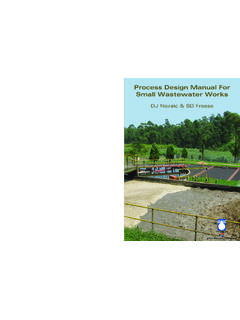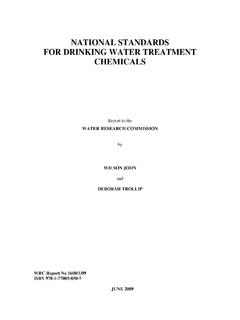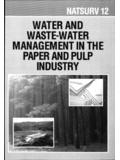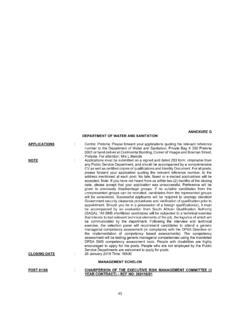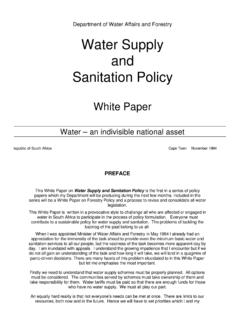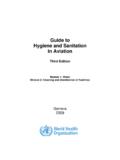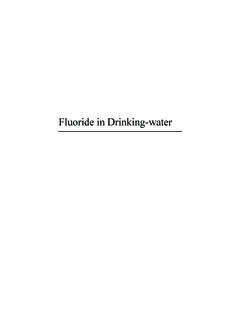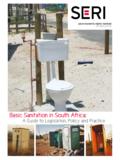Transcription of Evaluation of Sanitation Upgrading Programmes – …
1 Evaluation of Sanitation Upgrading Programmes The case of the Bucket Eradication programme Report to the water Research Commission by NP Mjoli Hlathi Development Services WRC Report No. 2016/1/12 ISBN 978-1-4312-0326-0 September 2012 ii Obtainable from water Research Commission Private Bag X03 GEZINA, 0031 or download from The following unpublished BEP case study reports which complement this report are available from Mr Jay Bhagwanat the water Research Commission on request Mangaung Municipality BEP case study Sol Plaatje Municipality BEP case study City of Matlosana BEP case study Makana Municipality BEP case study The following publication complements this report: Tokologo Municipality case study: Pilot implementation of the closed circuit wastewater Sanitation system, WinSA Lesson Series May 2011, DISCLAIMER This report has been reviewed by the water research Commission (WRC) and approved for publication.
2 Approval does not signify that the contents necessarily reflect the views and policies of the WRC, nor does mention of trade names or commercial products constitute endorsement or recommendation for use. water RESEARCH COMMISSION iii EXECUTIVE SUMMARY BACKGROUND The majority of municipalities used the conventional waterborne Sanitation system to replace buckets in urban formal settlements. This presented a challenge for municipalities servicing areas without bulk sewers and inadequate wastewater treatment capacity and in some cases the available water supply could not support the new waterborne Sanitation systems. The bucket Sanitation system was considered to be unhygienic and expensive to maintain and it violated the human dignity for the users and those responsible for collection and disposal of the human waste from bucket toilets. In February 2005, the bucket Sanitation backlog in formal townships was estimated at 252 254 buckets (DWAF, 2006).
3 Former President Mbeki, in his state of the nation address of February 2006, set a target for the eradication of all pre-1994 Sanitation buckets from the formal townships by December 2007. According to the Department of water Affairs close-out verification report of the bucket eradication programme (DWAF, 2009) between February 2005 and December 2007, the national government allocated a total of billion for the eradication of all pre-1994 buckets from formal townships. RATIONALE This study was initiated to assess what worked and what did not work, to evaluate the extent of compliance of the bucket eradication programme (BEP) with Sanitation policy principles and to assess the impact of the BEP on the quality of life for the beneficiary communities. There was a need to document lessons learned from the accelerated bucket eradication programme so that these lessons could inform the planning of future Sanitation Upgrading Programmes for households that were still using the bucket Sanitation system.
4 OBJECTIVES To evaluate the integration of Sanitation policy principles in the implementation of the bucket eradication programme . To assess the integration of water conservation and water demand management strategies in the implementation of waterborne Sanitation systems and consideration of water availability, wastewater treatment plant capacity and compliance with groundwater protocol. To evaluate the planning for O&M of Sanitation facilities within the context of free basic Sanitation services, household affordability and environmental sustainability. To assess household perceptions of the impact of the bucket eradication programme on the improvement in the quality of their lives. To evaluate the level of technical advice provided to municipalities by consulting engineers to assist them to implement technically and financially sustainable Sanitation systems.
5 To document best practice and highlight problem areas. iv To make recommendations for scaling-up good practice and initiatives necessary to rectify the identified problem areas. METHODOLOGY The study used five case study municipalities to conduct an in-depth Evaluation of the bucket eradication programme . Survey questionnaires for deployed engineers and beneficiary municipalities were used to assess the role played by the deployed engineers in the implementation of the BEP. Focus group discussions were held with representatives of the beneficiary communities in the five municipalities to assess their perceptions of the impact of the BEP on the quality of their lives and workshops were used to solicit inputs from the relevant Sanitation stakeholders. The study made use of secondary data to get a thorough understanding of Sanitation service delivery in the selected case study municipalities and surveyed municipalities.
6 The scope of the study included the Evaluation of the BEP and the broader aspects of Sanitation service delivery in selected provinces that had the bulk of bucket Sanitation backlog in February 2005. The study has focused on buckets which were eradicated between February 2005 and July 2009. One of the limitations of the study was that it was not possible to interview all the relevant municipal officials and councillors due to the difficulty in securing appointments with them. The change in municipal councillors due to the 2011 Local Government elections also negatively affected the interviews of relevant councillors who participated in the implementation of the accelerated BEP. KEY FINDINGS The following key findings emanated from the study: Extent of BEP compliance with Sanitation policy principles Ensuring access to basic Sanitation services as a right All case study municipalities complied with the Sanitation policy principle of ensuring access to basic Sanitation service as a right, they provided a 100% Sanitation subsidy to registered indigents.
7 However, they did not make any provision for meeting the special Sanitation needs of physically disabled, frail and other vulnerable groups. A one-size-fits-all toilet was constructed for each household. Integration of H&HE and user education into the BEP Health & Hygiene Education and user education were neglected by four case study municipalities, they claimed that these components were not included the BEP budget. The lack of user education contributed to the problem of regular blockage of household toilets due to the use of inappropriate materials for anal cleansing and disposal of foreign materials into the toilets. Community participation Only one out of five case study municipalities engaged the beneficiary households in the selection of the Sanitation technology option. One of the case study municipalities learned a costly lesson when it replaced buckets with VIP toilets without v consulting the beneficiary community.
8 These toilets were rejected and vandalized by the angry beneficiary community which demanded waterborne Sanitation facilities. Financial sustainability The decision to replace buckets with the waterborne Sanitation system was not based on a thorough assessment of affordability of this higher level of service for municipalities and the beneficiary households. All the case study municipalities were concerned about the long-term financial sustainability of the waterborne Sanitation system because the beneficiaries of the BEP were not paying for Sanitation services except in one case study municipality where households who were not registered as indigent were paying for Sanitation services. All five municipalities were facing a problem of increasing O&M costs for sewerage services because of high incidence of blocked drains and sewers which were caused by the use of inappropriate anal cleansing materials and disposal of foreign materials into the toilets.
9 Environmental sustainability Only one case study municipality conducted a thorough assessment of water availability, capacity of water supply infrastructure and wastewater treatment capacity before taking a decision to replace buckets with waterborne Sanitation system. Four case study municipalities received low average municipal Green Drop Scores (GDS) in the range of 0% to 52% and only one municipality received a score of 76% in the 2011 Green Drop assessment (DWA, 2011). The wastewater quality compliance ranged from 0% to 83% GDS for the five case study municipalities. The poor performance was attributed to the lack of technical skills, poor O&M and in some cases the wastewater treatment plants had already exceeded the design capacity. One of the case study municipalities was discharging non-compliant effluent from two of its plants because the wastewater treatment processes were compromised by high biological oxygen demand (BOD) wastewater from the abattoir and chicken industry which was discharged into municipal sewers without pre-treatment.
10 Integration of water conservation and water demand measures Four case studies municipalities did not include water saving measures during the installation of waterborne Sanitation systems. Only one case study municipality installed six litre cisterns in household toilets to save water . Perceptions of the impact of the BEP by beneficiary households The representatives of beneficiary communities who participated in focus group discussions in all five case study municipalities were satisfied with the waterborne Sanitation facilities which were convenient and safe for use by the children. They believed that the quality of their lives had improved and their human dignity was restored because they were no longer subjected to the dehumanizing buckets. The representatives of beneficiary communities from the four case study municipalities believed that the health of their children and the entire community had improved as a result of the replacement of buckets with the waterborne Sanitation facilities.

